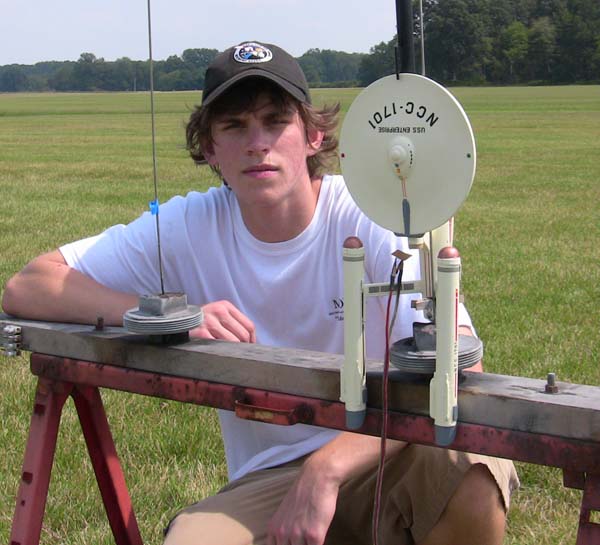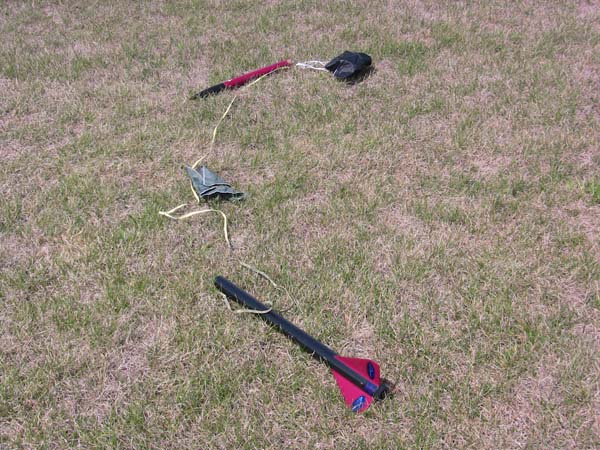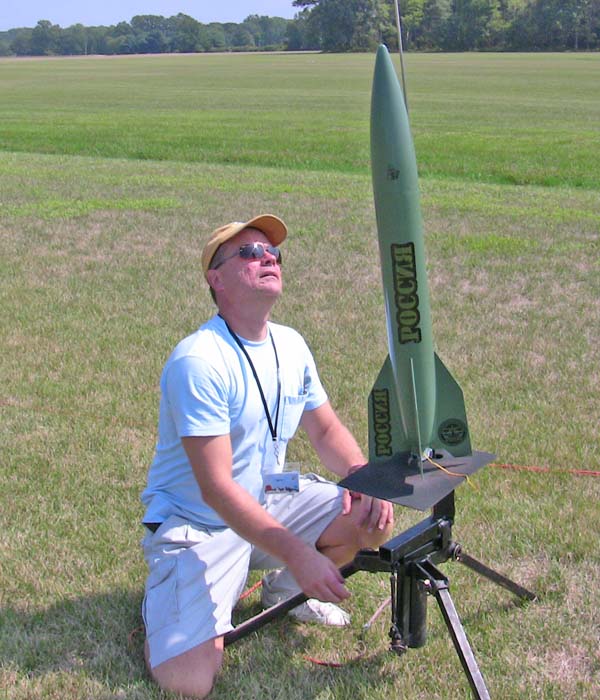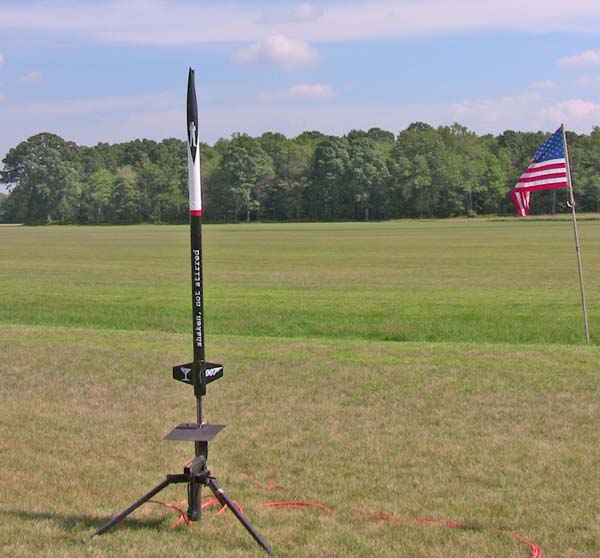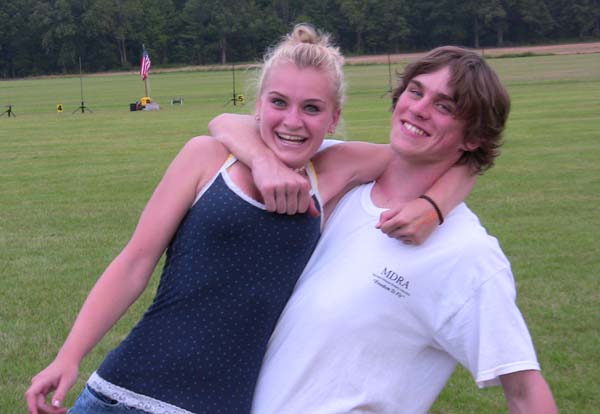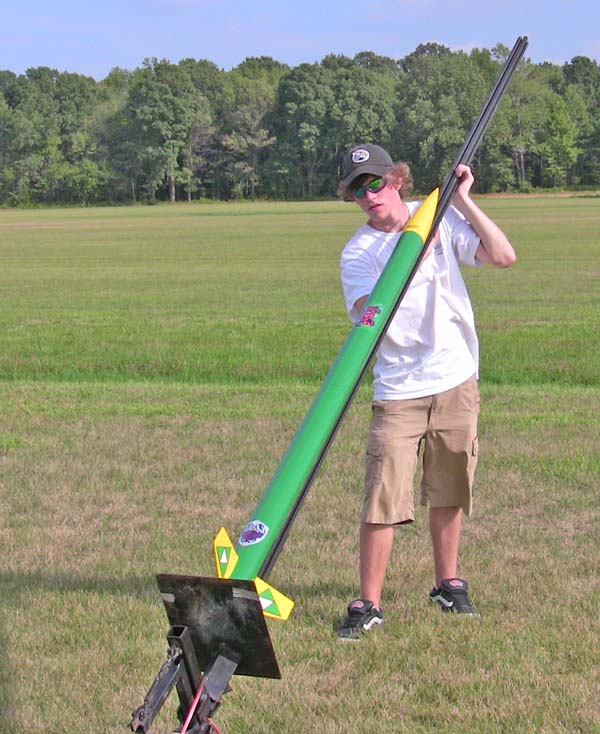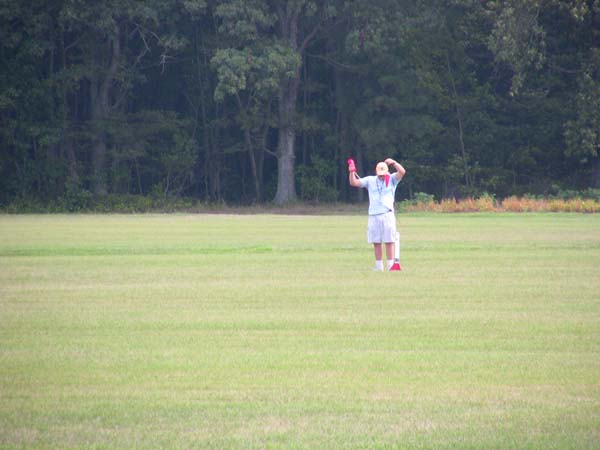![]()
The weather forecast during the week originally predicted a dismal weekend but by Friday the forecast improved. We gathered our rockets and left early Saturday morning, anticipating a long wait due to the advertised Bay Bridge repair work. There was no doom and gloom repair work as the Bay Bridge website warned and we arrived on Maryland’s Eastern Shore two hours ahead of schedule. We killed some time browsing the various antique stores as Monica fruitlessly pleaded to hit the outlet malls instead.
We arrived at the Central Sod Farm and assisted in setting up the field. This was to be our last launch at the Central Sod Farm for 2008. In October we will return to the vast grounds at the Higgs Dairy Farm in Price, Maryland. The remnants of Hurricane Hannah provided much needed rain the previous weekend and the sod was starting to recover its luscious green color and soft texture. The weather was hot and humid with partly cloudy skies. A slight intermittent breeze made it tolerable but it was quite sticky in between the puffs of air. It is a good thing that we love flying rockets.
The first rocket prepped for flight was Ben’s newly repaired Warp Drive sporting a new Star Fleet medical badge to commemorate its reactivation into the fleet. Ben had previously ignored the engine assembly instructions that led to a premature parachute deployment that zippered the main body tube during May’s launch. This time Ben followed the instructions for the Aerotech F52 engine to the “T”. Warp Drive warped off the pads and soon disappeared into the sky. It was spotted under chute and safely landed in the soft sod. Ben was happy. Witness Warp Drive’s return to active duty and listen for the whistle here.
Next was my R2/V2. A Loki G80 motor was inserted and R2/V2 was put on the pad. The breeze was blowing at this time so my top secret Optimal Trajectory Alignment Process was performed. The final countdown was started and when it reached zero, R2/V2 blasted into the sky reaching about 800 feet. The well-used yellow parachute deployed right on schedule and R2/V2 gently descended onto the lush, soft sod, where a fin proceeded to crack. This is the curse of flying V2 rockets. The fins protrude below the main body and a cracked fin is always the result if the rocket lands at just the right angle. This particular fin had cracked before and will be repaired once again. Poor R2/V2! It does not have many more repairs in her. Maybe one day I will retire it but for now, see the cool flight and its pendulum descent here.
My next rocket was Maxi Alpha. Maxi Alpha is a larger version of the Alpha III that I first assembled and flew back in 1972. Maxi Alpha was damaged in November 2007 when the parachute jammed in the body tube due to an insufficient ejection charge in the 24mm motor. This would be the first flight since it was repaired. This time the ejection charge was supplemented with additional black powder when the Aerotech E28 engine was assembled. The old style launch lugs were also replaced with rail buttons to allow a more stiff and vertical takeoff. Maxi Alpha once again took to the skies for a perfect flight and recovery. See its slow descent here.
Our much anticipated flight for the weekend was the maiden voyage of the USS Enterprise. The construction of this rocket was recently completed. This rocket was difficult to assemble with many fragile vacuum formed parts and way too many decals. We chose a mild manner black powder C6 to test the USS Enterprise’s flight characteristics. Everyone immediately recognized the USS Enterprise and was on their feet when the countdown started. When the button was pushed nothing occurred due to lost continuity. The launch leads were replaced and the countdown restarted. Once again everyone was on their feet. The button was pushed and again, nothing! It was still lack of continuity. The leads were cleaned and the third launch attempt was started. By this time the boy scouts had arrived and added to the excitement but disappointment prevailed again. This time the problem was traced to a shorted igniter. The igniter was replaced and the launch process started again. Everyone was back on their feet trying to coax the USS Enterprise into the air but to no avail.
At this time, the Scotty and Dr McCoy impressions became rampant with “she’s breaking apart captain”, and “I can’t hold her together much longer” being shouted from the flight line. Dr McCoy was also heard in the crowd yelling “I am a doctor, not an engineer” and “He’s dead, Jim”. The fifth countdown was completed and once again nothing. Dejected, embarrassed, and thinking this was an omen from the Rocket Gods, we proceeded to remove the USS Enterprise from the pads. At the last moment we decided to try a different pad. The sixth countdown was completed, the button pushed, and aye captain, there was a swoosh of the mighty C6 and the USS Enterprise proceeded to ascend into the sky and enter a standard orbit much to the excitement of all. The main parachute was ejected but never opened, but not to worry, Captain Kirk guided it to a safe landing. Go boldly where no man has gone before here.
The USS Enterprise had burn up 45 minutes of our time trying to get it into the air. It was time to recover our confidence and reputations so out came Shaken, Not Stirred. An old faithful Loki H144 was used as propulsion. Shaken, Not Stirred leapt off the launch pad right on queue and proceeded to 1348 feet where the drogue deployed directly above everyone’s heads. Shaken, Not Stirred descended straight down and the mains deployed at 400 feet. The rocket touched down on the flight line right in front of the over stimulated boy scouts and mere feet from the launch area. Witness my short retrieval walk here. After recovering Shaken, Not Stirred, we proceeded to eat lunch and drink much needed Gatorade as the slight breeze had disappeared by this time.
After a brief rest, Ben started to prep Legend of Zelda. This rocket had not flown since Red Glare IV. We loaded a Loki I405 motor which would be one of the larger motors flown during the day. We took Legend of Zelda to the pad but had difficulty arming the electronics. Despite our attempts, the arming switch in the rocket could not be located through the altimeter vent hole using the small screw driver. The rocket was broken apart on the pad and it was determined that Ben had the arming switch on the opposite side of the vent hole. The electronics bay was rotated 180 degrees and we were back in business. The electronics was then armed but the continuity beeps were not what we expected. There was a problem somewhere in the system. Legend of Zelda was removed from the pad and returned to the flight line so we could trace the problem.

